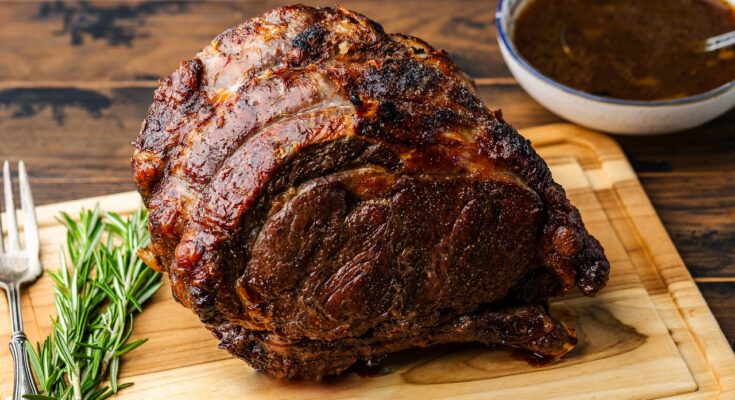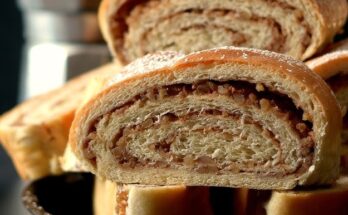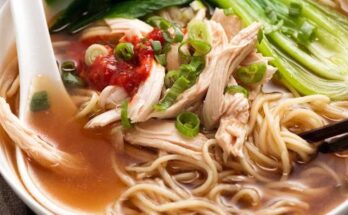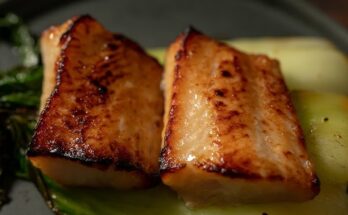Prime Rib Rub Recipe: There’s nothing quite as satisfying as slicing into a perfectly cooked prime rib—juicy, tender, and bursting with flavor. But the secret to a mouthwatering prime rib doesn’t lie solely in the cooking process—it starts long before the roast hits the oven. The true magic begins with the prime rib rub. This aromatic blend of spices, herbs, and seasonings transforms a simple roast into a restaurant-quality masterpiece.
In this detailed guide, we’ll walk you through everything you need to know about creating the perfect rub for your prime rib—from the ingredients you’ll need to step-by-step instructions that guarantee a flavor explosion. Whether you’re preparing it for a holiday feast, a weekend family dinner, or a special celebration, this guide will help you achieve a professional, chef-level result right at home.
Why Prime Rib Deserves a Perfect Rub
Prime rib is one of the most luxurious and flavorful cuts of beef. Its rich marbling and tenderness make it ideal for roasting. However, the key to elevating its natural flavor lies in the rub you choose. A good rub creates a savory crust—locking in the juices while forming a flavorful outer layer that enhances every bite.
Think of the rub as your prime rib’s best friend—it doesn’t overshadow the meat, it complements it. Whether you prefer a classic salt-and-pepper mix or a bold, herb-packed crust, the right rub can transform your roast from ordinary to extraordinary. The perfect rub brings together balance: saltiness, a hint of spice, herbal aroma, and a touch of sweetness.
The reason professional chefs spend time perfecting their rubs is simple—the first impression of a prime rib comes from that outer crust. It’s what guests smell before they taste, and it’s what gives your roast its signature “wow” factor.
Understanding the Role of a Rub in Flavor Enhancement
A rub serves more than one purpose—it not only seasons the surface but also helps create texture and depth. The salt draws out a bit of moisture from the meat, which then mixes with the spices to form a natural marinade. During roasting, this mixture caramelizes and fuses into the meat’s exterior, producing a delicious crust known as the “bark.”
Dry rubs are particularly popular for prime rib because they stick to the meat easily and create that signature golden-brown finish. However, some cooks prefer a paste-style rub, which uses a bit of oil or butter to help the flavors penetrate deeper. Both styles work beautifully, depending on your flavor preference and cooking method.
Ultimately, a good rub transforms the entire dining experience—turning a simple cut of meat into a centerpiece dish that captivates everyone at the table.
Ingredients You’ll Need
Before diving into the process, let’s gather all the ingredients that will make your prime rib rub irresistible.
Essential Spices and Herbs
Here’s a list of classic ingredients for a perfect prime rib rub:
| Ingredient | Quantity | Purpose |
|---|---|---|
| Kosher Salt | 2 tbsp | Enhances flavor and helps form crust |
| Black Pepper (freshly cracked) | 2 tbsp | Adds a subtle heat and aroma |
| Garlic Powder | 1 tbsp | Provides depth and savory notes |
| Onion Powder | 1 tbsp | Balances the garlic and adds richness |
| Dried Thyme | 1 tsp | Brings earthy herbal tones |
| Dried Rosemary | 1 tsp | Adds a fragrant, woody aroma |
| Smoked Paprika | 1 tsp | Introduces a hint of smokiness |
| Brown Sugar | 1 tsp | Balances the saltiness with mild sweetness |
These simple, everyday ingredients combine to form a balanced and flavorful rub that highlights the natural taste of your beef without overpowering it.
Optional Add-Ons for Personalization
The beauty of a prime rib rub is that you can easily customize it to your taste. Here are some optional ingredients to elevate your flavor game:
- Crushed Red Pepper Flakes: Adds a touch of heat for spice lovers.
- Dijon Mustard or Olive Oil: Helps create a paste rub and enhances moisture.
- Ground Cumin: Adds a smoky, earthy undertone.
- Lemon Zest or Orange Peel: Gives a fresh, citrusy lift to balance rich flavors.
- Fresh Herbs (like parsley or sage): Add brightness and color.
- Horseradish Powder: For a bold, peppery kick often found in steakhouse recipes.
Experimenting with different combinations helps you discover your own signature rub—perfectly tailored to your taste.
Tips for Selecting High-Quality Ingredients
- Choose Coarse Salt: Fine salt can make the rub too salty and overpowering. Coarse kosher salt provides texture and even distribution.
- Use Freshly Cracked Pepper: Pre-ground pepper loses its punch quickly; freshly cracked peppercorns ensure a bold flavor.
- Opt for Fresh Herbs When Possible: Dried herbs work well, but fresh herbs release essential oils that add vibrancy.
- Avoid Stale Spices: Old spices lose aroma and flavor. A quick smell test can tell you if they’re still potent—if they smell weak, it’s time to replace them.
High-quality ingredients make all the difference between a good roast and a show-stopping centerpiece.
Tools and Equipment Required
Basic Kitchen Tools
You don’t need fancy equipment to make a prime rib rub, but having the right tools makes the process smoother. Here’s what you’ll need:
- Measuring Spoons: Accuracy matters when blending spices.
- Mixing Bowl: For combining all dry ingredients evenly.
- Whisk or Spoon: Helps break up clumps in the spices.
- Small Container or Jar: For storing any leftover rub.
Optional Tools for Advanced Cooks
- Mortar and Pestle: Perfect for crushing fresh herbs and spices for enhanced flavor.
- Spice Grinder: Great for achieving an even consistency when working with whole spices.
- Basting Brush: Useful if you’re applying an oil-based rub.
Having these tools on hand not only simplifies your prep work but also ensures consistency in every batch you make.
Preparing Your Prime Rib
Choosing the Best Cut of Prime Rib
When it comes to prime rib, the quality of the meat is just as important as the rub itself. Look for a bone-in rib roast (often labeled as “standing rib roast”) for maximum flavor and tenderness. The bones help retain moisture during roasting and add depth to the taste.
Choose USDA Prime grade if possible—it offers superior marbling, which ensures juiciness and flavor. If Prime isn’t available, USDA Choice is a great alternative. Avoid overly lean cuts, as they tend to dry out.
Trimming and Cleaning the Meat
Before seasoning, check the roast for excess fat or silver skin (a thin membrane). While you want to leave a generous fat cap for flavor, trimming excess fat ensures your rub adheres better. Rinse the roast lightly and pat it completely dry with paper towels.
Drying is crucial because moisture prevents the rub from sticking properly. Think of it as prepping a canvas—the drier the surface, the better your rub will cling and develop that golden crust.
Bringing the Meat to Room Temperature
Allow your prime rib to sit out for about 1 to 2 hours before applying the rub. This step ensures even cooking from edge to center. Cold meat placed directly in the oven cooks unevenly, resulting in an undercooked center and overdone exterior.
Room-temperature meat also allows the rub to penetrate more effectively, infusing deeper flavor throughout the roast.
Step-by-Step Guide to Making the Perfect Prime Rib Rub
Step 1 – Measuring and Mixing Your Spices
Start by gathering your key ingredients: 2 tablespoons of kosher salt, 1 tablespoon of cracked black pepper, 1 tablespoon of garlic powder, 1 tablespoon of onion powder, 1 teaspoon of dried rosemary, 1 teaspoon of thyme, and ½ teaspoon of smoked paprika. Combine all the spices in a small bowl and mix thoroughly to ensure an even blend of flavors.
Step 2 – Creating the Rub Paste
Add 2–3 tablespoons of olive oil or softened butter to the spice mix and stir until it forms a thick, spreadable paste. The oil or butter helps the spices stick to the meat and creates a flavorful crust when roasted.
Step 3 – Applying the Rub to the Prime Rib
Pat your prime rib dry with paper towels — moisture prevents proper browning. Then, using your hands, massage the rub paste generously over the entire surface of the meat, making sure to coat every side and crevice. Don’t be shy — a thick rub layer means a richer flavor crust later.
Step 4 – Letting It Marinate for Maximum Flavor
For best results, place the seasoned prime rib on a wire rack over a tray, cover loosely with foil or plastic wrap, and refrigerate it for at least 4 hours — ideally overnight. This resting time allows the salt and spices to penetrate deeply into the meat, amplifying the flavor and tenderness.
Step 5 – Roasting the Perfect Prime Rib
When ready to cook, let the meat come to room temperature for about an hour. Preheat your oven to 450°F (230°C). Roast the prime rib for 15–20 minutes to develop a crust, then lower the temperature to 325°F (160°C) and continue roasting until the internal temperature reaches your desired doneness (about 120°F for medium-rare). Rest the meat for at least 20 minutes before carving — this keeps the juices locked in.
Tender, juicy, and bursting with herbaceous, garlicky flavor — this prime rib rub guarantees a show-stopping centerpiece every single time!
Pro Tips for the Ultimate Prime Rib Flavor
Balancing Salt and Sweetness
One of the secrets to a truly memorable prime rib rub lies in balance. Salt enhances the meat’s natural savoriness, while sugar adds subtle caramelization. However, too much of either can ruin the texture or taste. Stick to a 2:1 ratio of salt to sugar, adjusting slightly depending on your preference. Remember, the meat itself is rich and fatty, so a touch of sweetness helps cut through that richness.
How Long Should You Let It Sit?
Patience pays off when it comes to prime rib. The longer your rub sits, the deeper the flavor penetration. For best results, let the seasoned meat rest for a full 24 hours in the refrigerator. If time is tight, even 6 hours will work, but don’t skip the marination entirely—it makes a remarkable difference in tenderness and flavor.
The Secret of Resting the Meat After Roasting
Once your prime rib comes out of the oven, resist the urge to cut into it right away. Resting allows the juices, which have been driven toward the center during cooking, to redistribute evenly throughout the roast. If you slice it too early, those juices spill out, leaving your meat dry.
Cover the roast loosely with foil and let it rest for 20–30 minutes before carving. The temperature will rise slightly during this time, bringing it to the perfect level of doneness. The result? A juicy, tender slice that melts in your mouth.
Common Mistakes to Avoid
Over-Salting or Under-Seasoning
One of the biggest mistakes home cooks make with prime rib is misjudging the amount of seasoning. Prime rib is a large and thick cut of meat, so it requires more seasoning than you might expect. If you under-season, the inner meat will taste bland even if the crust is flavorful. On the flip side, adding too much salt can overpower the meat and make it unpleasantly salty.
To avoid over-salting, always use coarse kosher salt instead of table salt. Coarse salt crystals dissolve more slowly, spreading flavor evenly and preventing saltiness from concentrating in one area. A general rule is one teaspoon of kosher salt per pound of meat. Combine it with your herbs and spices for a balanced flavor.
Also, don’t forget to season all sides of the roast. Many people focus only on the top surface, but the sides and bottom deserve just as much attention. Think of your roast as a canvas that needs full coverage for the perfect flavor payoff. If you’re new to cooking prime rib, it’s better to start with a moderate amount of salt and adjust your rub proportions next time based on the results.
Rubbing Too Early or Too Late
Timing is everything when it comes to applying your rub. Applying it too early (without proper refrigeration) can cause the meat to become mushy as the salt draws out too much moisture. On the other hand, rubbing too late—right before cooking—doesn’t give the seasoning enough time to penetrate the surface, leading to a less flavorful roast.
The sweet spot is to rub the prime rib 12–24 hours before roasting and let it rest in the refrigerator uncovered. This method, known as dry brining, allows the salt and seasonings to sink deep into the meat while also drying the exterior slightly, creating that gorgeous brown crust when roasted.
Avoid sealing your roast tightly in plastic wrap during this time—it traps moisture and prevents proper crust formation. Instead, let it sit uncovered on a wire rack over a tray. This setup ensures even air circulation and perfect seasoning absorption.
Perfect Side Dishes for Prime Rib
A beautifully roasted prime rib deserves equally impressive side dishes. Whether you’re serving it for Christmas dinner or a special family meal, the right accompaniments can take your dining experience to the next level.
Classic Pairings
- Creamy Mashed Potatoes: The velvety texture of mashed potatoes balances the rich and hearty flavor of prime rib. Add a touch of roasted garlic or parmesan for extra depth.
- Yorkshire Pudding: A traditional British favorite that pairs perfectly with prime rib. These light, airy pastries soak up the beef drippings beautifully.
- Roasted Vegetables: Carrots, Brussels sprouts, and parsnips roasted with olive oil, salt, and rosemary complement the roast’s flavors without overpowering them.
- Au Jus Sauce: A simple pan drippings sauce made with beef broth and a splash of red wine enhances every slice with savory richness.
- Creamed Spinach: This steakhouse classic offers a creamy, tangy contrast to the beefy main dish.
Modern and Creative Options
If you’re looking to impress your guests with something a little different, try one of these contemporary side dishes:
- Truffle Mac and Cheese: A luxurious twist on comfort food that pairs beautifully with prime rib’s bold flavors.
- Cauliflower Gratin: A low-carb, cheesy alternative that adds a hint of nuttiness.
- Garlic Butter Green Beans: A light and zesty side that cuts through the richness of the meat.
- Balsamic-Glazed Carrots: Sweet, tangy, and colorful—these add a lovely pop to your plate.
- Horseradish Cream Sauce: A zesty condiment that enhances the roast’s flavor while adding a bit of heat.
No matter which sides you choose, aim for balance—pair rich dishes with something light and refreshing to prevent your meal from feeling too heavy.
Storing and Reusing Leftover Rub
You’ll likely end up with some extra rub, and the good news is that it stores beautifully for future use. Whether you’re grilling, roasting, or pan-searing, this rub can add incredible flavor to other meats as well.
Proper Storage Methods
Store your leftover rub in an airtight glass jar or container. Keep it in a cool, dark place away from sunlight and moisture. A pantry cabinet or spice drawer works perfectly. If you’ve made a dry rub, it can last for up to 6 months. For a paste rub containing oil or butter, store it in the refrigerator and use it within 1–2 weeks.
If you live in a humid area, consider adding a small piece of uncooked rice to the container—it helps absorb excess moisture and keeps your rub fresh and clump-free.
Always label your container with the date you made it. Spices lose their potency over time, so freshness is key for maintaining bold flavors.
Creative Ways to Use Extra Rub
Don’t let your leftover rub go to waste! Here are some fun and delicious ways to repurpose it:
- Steaks and Burgers: Sprinkle a little over your next steak or burger patty before grilling for an instant flavor upgrade.
- Roasted Chicken: The blend of herbs and spices works beautifully on poultry, especially with olive oil and lemon.
- Vegetable Seasoning: Toss vegetables in olive oil and a bit of the rub before roasting. It adds smoky, savory notes that elevate even simple dishes.
- Potato Seasoning: Mix with melted butter and drizzle over baked or mashed potatoes.
- Soup Enhancer: Add a pinch to beef stew, chili, or vegetable soup for extra depth of flavor.
Once you realize how versatile your rub is, you’ll start using it in countless ways—it’s like having your own signature house seasoning blend.
FAQs about Prime Rib Rub Recipe
1. Can I make the prime rib rub in advance?
Absolutely! In fact, making it ahead of time allows the flavors to meld together. Store it in an airtight container for up to six months if it’s a dry rub.
2. Should I use fresh or dried herbs?
Both work wonderfully. Dried herbs have a more concentrated flavor, while fresh herbs add brightness. If using fresh, double the quantity since they’re less potent.
3. Can I use this rub on other cuts of meat?
Yes! This rub is incredibly versatile. It works on steaks, brisket, chicken, pork, and even roasted vegetables.
4. How do I make the rub spicier?
Add cayenne pepper, crushed red pepper flakes, or chipotle powder to taste. Start small—you can always add more later.
5. What’s the best way to ensure a crispy crust?
Leave the seasoned prime rib uncovered in the refrigerator for at least 12 hours before roasting. This allows the surface to dry slightly, leading to a perfectly crisp crust when cooked.
Conclusion
A perfectly seasoned prime rib isn’t just a meal—it’s an experience. The secret lies in the rub: a balanced blend of salt, spices, and herbs that enhances the natural richness of the beef while creating an irresistible crust. From choosing quality ingredients to mastering the art of marination and roasting, each step contributes to that show-stopping final result.
Remember, patience and precision are your best tools in the kitchen. With this prime rib rub recipe and step-by-step guide, you can confidently serve a roast that’s tender, flavorful, and absolutely unforgettable. Whether it’s for a festive holiday dinner or a cozy weekend feast, your prime rib will steal the show.
So grab your spices, roll up your sleeves, and let your kitchen fill with the mouthwatering aroma of perfectly seasoned prime rib—it’s time to impress your guests and yourself.



